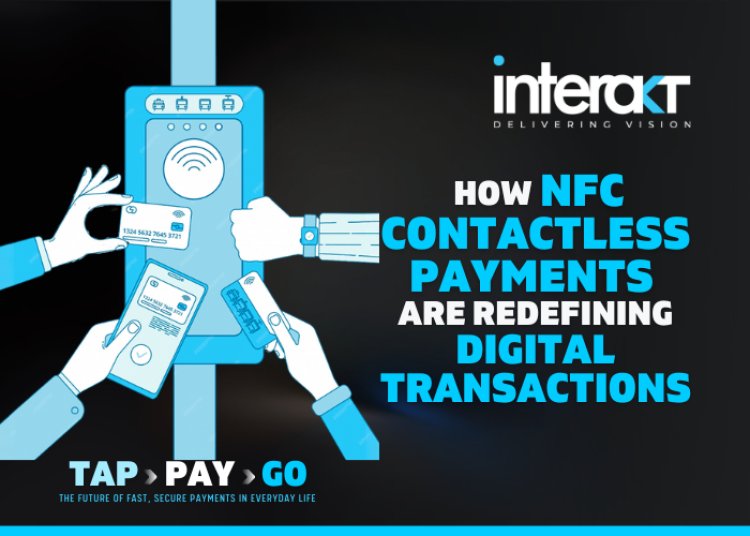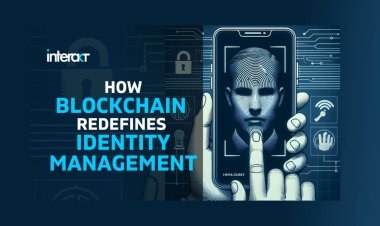How NFC Contactless Payments Are Redefining Digital Transactions
In this comprehensive guide by Interakt Techsol, we explore how NFC (Near Field Communication) is revolutionizing contactless payments across India, Japan, and Southeast Asia. From retail and healthcare to transport and hospitality, NFC enables secure, tap-to-pay experiences that are fast, hygienic, and user-friendly. We break down how NFC works, compare it to QR/UPI/cash/card, and outline a step-by-step guide for businesses to integrate NFC-powered POS systems. With insights into regional adoption, payment gateway integration, mobile wallet compatibility, and industry-specific use cases, this blog is essential for fintech leaders, developers, and digital transformation teams.

In this comprehensive guide by Interakt Techsol, we explore how NFC (Near Field Communication) is revolutionizing contactless payments across India, Japan, and Southeast Asia. From retail and healthcare to transport and hospitality, NFC enables secure, tap-to-pay experiences that are fast, hygienic, and user-friendly.
We break down how NFC works, compare it to QR/UPI/cash/card, and outline a step-by-step guide for businesses to integrate NFC-powered POS systems. With insights into regional adoption, payment gateway integration, mobile wallet compatibility, and industry-specific use cases, this blog is essential for fintech leaders, developers, and digital transformation teams.
● NFC contactless payments enable transactions in under 3 seconds with a simple tap.
● Transactions use encrypted, one-time-use tokens for high-security digital payments.
● Reduces physical contact, improving hygiene in post-COVID retail and healthcare settings.
● Widely adopted in Japan (Suica, PayPay) and rapidly growing in India (GPay, Paytm, PhonePe).
● Businesses report 40–60% faster checkout times using NFC POS terminals.
● Compatible with Apple Pay, Google Pay, Suica, and other regional mobile wallets.
● Offers real-time analytics on payment behavior, trends, and customer insights.
● Supports offline NFC transactions in transportation and smart mobility sectors.
● Applicable across industries: retail, healthcare, F&B, transport, and hospitality.
● Lowers hardware maintenance and payment processing costs over time.
● Enables omnichannel integration with CRM systems, loyalty programs, and mobile apps.
● Built to support both Japan’s FeliCa standard and India’s EMV/NFC ecosystem.
● Interakt Techsol provides end-to-end NFC integration, from POS infrastructure setup to secure gateway development and mobile wallet integration.
In today’s digital-first world, waiting in line to swipe a card or dig for change feels outdated. With rising consumer demand for speed, hygiene, and convenience, NFC contactless payments have become a global standard, quietly reshaping how people pay, from Tokyo to Mumbai and everywhere in between.
This blog explores how NFC is revolutionizing payments, how businesses can integrate it, and why companies across retail, healthcare, and transport are making the switch. Whether you're looking to modernize your payment infrastructure or launch an NFC-ready mobile wallet, this guide covers everything you need.
What is NFC in Digital Payments?
Have you ever found yourself running late, only to be delayed even further by a faulty card reader or a long queue at the register? In those moments, we all crave a payment method that’s faster, simpler, and more reliable. That’s exactly where NFC (Near Field Communication) technology steps in.
NFC is a short-range wireless communication protocol that enables two devices—such as your smartphone and a point-of-sale (POS) terminal—to exchange data when held just a few centimeters apart. It’s the invisible handshake behind what we now call contactless payments.
In digital payments, NFC allows your mobile phone, smartwatch, or contactless card to function as a secure digital wallet. Once authenticated (via fingerprint, Face ID, or passcode), your device transmits encrypted payment data directly to the POS system, completing the transaction in a matter of seconds.
Key Market Insights:
● Contactless payments growing 250% annually in major Asian markets
● Average NFC transaction completes in under 5 seconds
● Businesses report a 40-60% reduction in checkout times
● Customer satisfaction increases by 35% with contactless options
Thanks to real-time tokenization and advanced encryption protocols, NFC payments are not only more convenient but also more secure than traditional swipe or chip-based transactions.
Whether you're tapping to pay for coffee in Tokyo or groceries in Mumbai, NFC makes payments faster, cleaner, and safer, with just one simple gesture.
How Do NFC Mobile Payments Work?
Here's a step-by-step breakdown of how NFC payments function:
- Card Setup
Users add their bank card to an NFC-supported mobile wallet (Apple Pay, Google Pay, Suica, etc.) - Activation
At checkout, the user opens the wallet and unlocks the device. - Tap & Authenticate
Device is held near an NFC-enabled terminal. Authentication occurs via Face ID, fingerprint, or passcode. - Transaction Completion
Encrypted tokens are sent to the terminal and processed via a payment gateway—usually in under 3 seconds.
Payment Method Comparison
|
Aspect |
Cash Payment |
Traditional Card |
NFC Contactless |
|
Transaction Speed |
30-60 seconds |
15-30 seconds |
2-5 seconds |
|
Security Level |
Basic |
Standard |
Advanced |
|
Contact Required |
Yes |
Yes |
No |
|
Processing Cost |
High |
Medium |
Low |
|
User Convenience |
Limited |
Good |
Excellent |
|
Setup Complexity |
None |
Medium |
Simple |
How Can Businesses Implement NFC Payments Effectively?
Adopting NFC (Near Field Communication) for your business isn’t just about modernizing—it's about future-proofing your payment infrastructure. As contactless becomes the global norm, businesses that embrace NFC now gain a competitive edge in speed, customer experience, and operational efficiency.
Step-by-Step Guide to Implementing NFC Payments
- Assess & Upgrade POS Infrastructure
Start by evaluating your current POS terminals. Ensure they support NFC, or upgrade to certified NFC-enabled hardware compatible with contactless standards (like EMVCo, FeliCa, etc.). - Activate NFC Functionality
Configure your terminals to accept NFC transactions. This includes enabling radio frequency protocols and ensuring compatibility with major mobile wallets (Google Pay, Apple Pay, PayPay, Suica, etc.). - Integrate a Secure Payment Gateway
Connect your systems to a PCI-DSS-compliant payment gateway that supports real-time tokenization, encryption, and multi-wallet support. This ensures transactions are both fast and secure. - Develop or Integrate Mobile Apps
Whether you're building an in-house mobile wallet or integrating with third-party apps, ensure the app supports NFC tap-to-pay, loyalty sync, and real-time receipts. - Train Employees on NFC Workflows
Equip your staff with the knowledge to guide customers, handle payment errors, and manage NFC transactions efficiently. A well-informed team enhances adoption and customer satisfaction.
Why Forward-Thinking Businesses Are Choosing NFC Payments
Businesses around the world—especially in high-volume, customer-facing industries—are switching to NFC-enabled payments for a host of reasons:
● Faster Checkout Speeds
Reduce average transaction times to under 3 seconds—ideal for busy retail environments and rush-hour service counters.
● Elevated Customer Experience
Mobile-first customers value frictionless, one-tap experiences. NFC delivers precisely that.
● Enhanced Transaction Security
Tokenization and biometric authentication make NFC payments safer than traditional card swipes or even QR codes.
● Improved Hygiene
In a post-COVID world, minimizing physical contact is a must. Contactless payments are cleaner and safer.
● Reduced Operating Costs
NFC reduces cash handling, manual key-ins, and hardware maintenance costs over time.
● Unified Omnichannel Experience
NFC integrates with CRMs, loyalty programs, and cloud-based platforms—bridging offline and online journeys.
● Lower Error Rate
Automated tap-to-pay eliminates human error from manual inputs or miskeyed totals.
● Boosted Sales Conversions
Shorter queues and faster transactions lead to happier customers—and more purchases.
● Actionable Analytics
NFC-enabled systems provide rich data: payment times, customer behavior, purchase trends, and conversion rates.
● Future-Proof Infrastructure
By adopting NFC now, businesses avoid future compatibility issues and maintain a tech-forward brand image.
NFC in India and Japan: Regional Adoption Insights
Japan
● Japan pioneered NFC adoption through FeliCa-based IC cards (Suica, PASMO, nanaco)
● Used extensively in public transit, retail, vending machines, and hospitality
● Apple Pay and Google Pay support FeliCa and global NFC standards
● Over 8 million NFC payments daily on Tokyo Metro alone
India
● The Reserve Bank of India permits tap-to-pay without PIN for transactions under ₹5,000
● NFC-enabled debit/credit cards are issued by all major banks
● Wallet apps like GPay, Paytm, and PhonePe now support NFC + UPI hybrid models
● POS terminal penetration with NFC capabilities is growing across Tier 1 and Tier 2 cities
Industry Applications & Benefits of NFC Payments
NFC-powered contactless payments aren’t just a technological upgrade—they’re a strategic advantage across multiple industries. By streamlining the way payments are made and processed, businesses are unlocking measurable improvements in speed, safety, and customer satisfaction.
1. Retail: Higher Efficiency & Happier Customers
In fast-paced retail environments—especially fashion and electronics—NFC payments significantly reduce checkout times. This helps brands handle more foot traffic during peak hours, resulting in faster billing, shorter queues, and a noticeable boost in customer satisfaction scores. Many retail chains also sync loyalty programs and digital receipts through NFC, enriching the post-purchase experience.
2. Public Transport: Speed Meets Scalability
From Tokyo Metro to Indian smart city bus systems, transit operators leverage NFC to cut platform congestion, enable touchless entry, and reduce fare evasion. Prepaid NFC-enabled passes or mobile wallets provide real-time usage data, improving fleet scheduling and service reliability.
3. Food & Beverage: Peak-Time Optimization
Restaurants and quick-service chains are turning to NFC to accelerate order processing during lunch and dinner rushes. Drive-throughs, kiosks, and digital menus integrated with tap-to-pay functionality reduce bottlenecks and free up staff to focus on service—not transaction handling.
4. Healthcare: Cleaner, Smarter Payment Experiences
In hospitals, pharmacies, and diagnostic centers, NFC enhances both hygiene and efficiency. Patients can settle bills via contactless payments, minimizing surface contact and wait times—especially crucial in infection-sensitive environments.
Powering Contactless Payments with Gateway Integration
Behind every seamless NFC transaction is a secure, agile, and intelligent payment gateway. This gateway ensures that funds move from the customer's bank to the merchant’s account in real time—securely, compliantly, and transparently.
Key Requirements for NFC-Enabled Gateways:
● Tokenization & Encryption: Protect sensitive card data with dynamic tokens and secure encryption protocols.
● Multi-Wallet Compatibility: Support all major wallets like Apple Pay, Google Pay, Suica, Paytm, and more.
● Real-Time Reporting: Track and analyze every transaction with built-in data dashboards.
● Scalable APIs: Ensure smooth integration with mobile apps, POS systems, CRMs, and ERPs.
Whether you’re in retail, transportation, healthcare, or hospitality, the success of your NFC system hinges on seamless, secure backend connectivity
Is NFC Available in Popular Payment Apps?
Yes! NFC is available in major payment applications in both markets.
Google Pay: Available on NFC-enabled Android devices in both India and Japan. Users can add their cards and tap their device at POS terminals to make payments.
Apple Pay: Fully supported in Japan and expanding in India. iPhone users can make contactless payments with Face ID or Touch ID authentication.
Regional Apps:
● India: Paytm, PhonePe, and banking apps increasingly support NFC
● Japan: PayPay, LINE Pay, and Rakuten Pay offer NFC capabilities
To use NFC in these apps:
● Ensure your phone has NFC capabilities
● Turn on NFC from your device settings
● Open your payment app, add your card, and verify it
● Authenticate and tap your phone on the terminal
What Goes Into NFC Integration
To make contactless work flawlessly, developers must manage:
● Wallet SDK integration (Apple Pay, Google Pay, FeliCa)
● POS terminal software customization
● Backend token handling + secure encryption
● Offline mode support
● Blockchain-based transaction audit logs (optional)
Why NFC Is the Future of Digital Payments
In today’s fast-paced, mobile-first world, consumers no longer tolerate long queues, cash fumbling, or remembering multiple PINs. Whether you’re shopping in Tokyo, commuting in Mumbai, or dining in Singapore, users expect digital payments to be instant, secure, and contactless and NFC (Near Field Communication) delivers exactly that.
The Experience Consumers Demand
With a simple tap or hover of a smartphone or smartwatch near a POS terminal, an NFC transaction is completed in under two seconds no swiping, no PIN (within limits), and no physical contact. This isn’t a convenience anymore it's the new normal for in-store payments.
It’s Not Just Faster, It’s Safer
NFC payments are backed by bank-grade encryption and tokenization, which replace actual card numbers with one-time-use tokens. This ensures that sensitive data is never shared during the transaction.
Plus, biometric authentication via Face ID, fingerprint, or device passcode makes it nearly impossible for unauthorized transactions to occur, even if a device is lost or stolen.
Universally Compatible, Seamlessly Scalable
Whether users are paying via Google Pay in India, Apple Pay in Japan, or Suica, PayPay, or LINE Pay in retail and transport, NFC offers cross-platform compatibility that works reliably across smartphones, wearables, and even IoT devices.
It’s this versatility and ease of use that’s making NFC the global standard for digital payments in retail, hospitality, transit, and healthcare industries.
NFC isn’t a trend, it’s a transformation. As contactless adoption accelerates across India, Japan, and Southeast Asia, businesses that embrace this technology now will be better positioned for tomorrow’s market demands.
At Interakt TechSol, we’re exploring NFC-ready innovations—bringing together expertise in mobile apps, fintech platforms, IoT, and secure data systems. Our goal is to support businesses that want to lead in future-ready digital transactions.
Interested in exploring NFC possibilities for your brand?
Reach out to our digital strategy team to learn how we can help you shape what’s next in contactless commerce.
FAQs
Q1. What is NFC, and how does it work in contactless payments?
NFC (Near Field Communication) enables short-range wireless communication between devices like smartphones and POS terminals. Digital payments let users tap their device to complete secure, encrypted transactions in seconds.
Q: Is NFC payment legal in India and Japan?
Yes. It is widely supported by regulators in both countries. Japan was among the first adopters. In India, NFC is allowed for card-based tap-to-pay transactions up to ₹5,000 without PIN.
Q: Is NFC available in apps like Google Pay or Suica?
Yes. Apple Pay, Google Pay, Suica, PayPay, PhonePe, and others fully support NFC-based payments on supported devices.
Q: What’s the difference between NFC and UPI or QR?
● NFC: Hardware-based, contactless, ultra-fast
● UPI: Software-based, requires internet and PIN
● QR: Visual scan with camera, more manual
Q: Can NFC work offline?
Yes, some devices support offline transaction queuing and processing (especially in transport).
Q4. What industries benefit most from NFC payments?
Retail, healthcare, transport, food and beverage, and hospitality benefit greatly through faster checkouts, hygiene, and seamless integrations.
Q5. How can Interakt Techsol help with NFC adoption?
Interakt Techsol offers end-to-end NFC payment solutions: POS integration, mobile wallet development, secure backend with tokenization, and regional compliance support across India and Japan.












